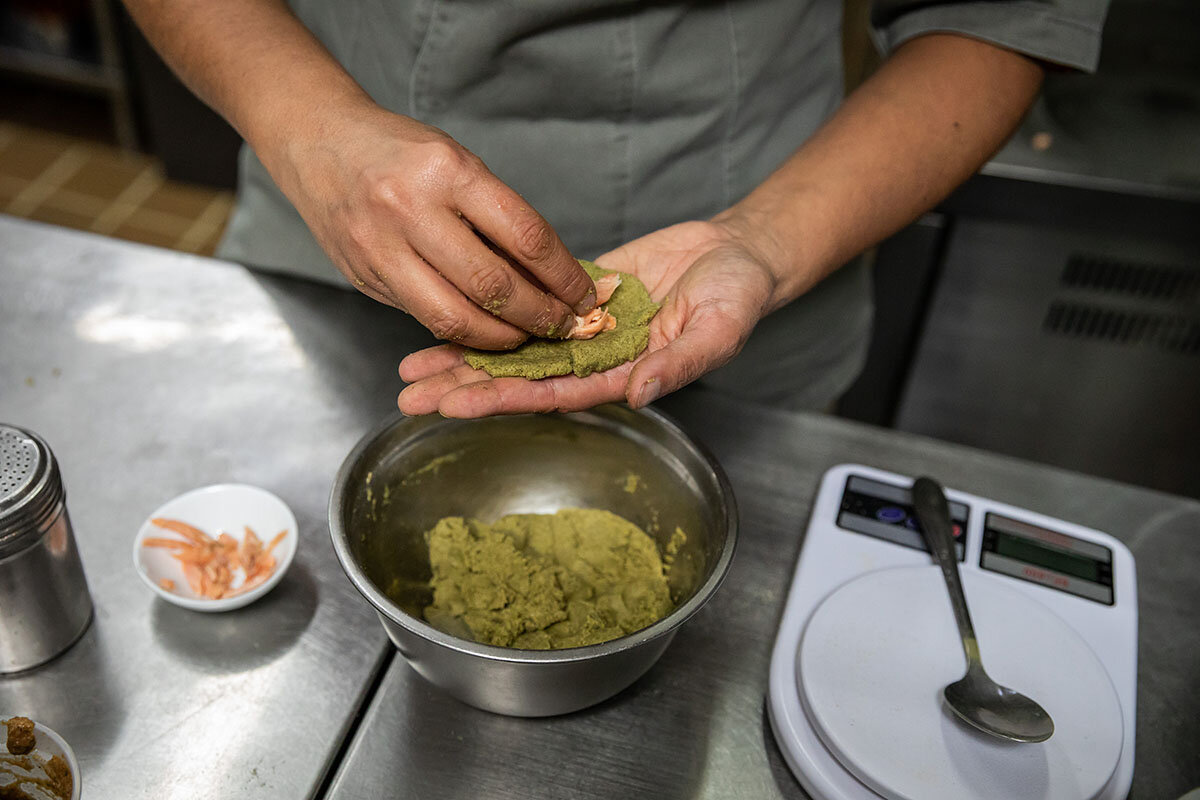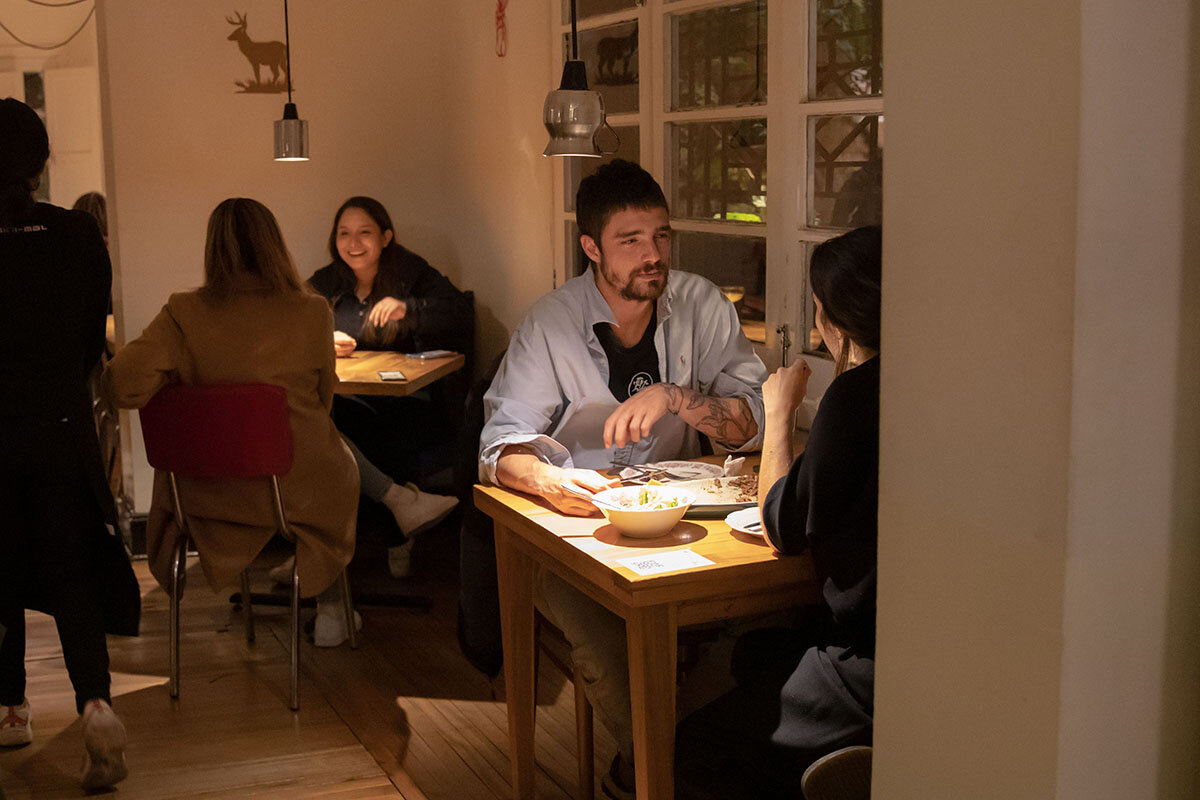Colombian chefs aim to decolonize national diet – with the coca leaf
Loading...
| Bogotá, Colombia
Friday lunchtime at Mini-Mal, a Bogotá restaurant of modern Colombian cuisine housed in a pretty, two-story Victorian edifice, was buzzing with a crowd in suits and heels.
In the back, Antonuela Ariza, the chef, readied the day’s special: the Color of the Andes. It is composed of purple, pink, and yellow tubers, native crops of the South American highlands, and the plate’s highlight was a crispy pastry, wrapping bright, smoky trout in a casing crafted out of coca powder.
On any given day, hundreds of coca plants, the raw source of cocaine, are yanked from the soil by anti-narcotics police patrolling far-flung corners of rural Colombia. But here in this upscale kitchen, coca is being redefined by Ms. Ariza as she plunges a pistachio-green mass, molded into the shape of a crescent, into a deep fryer. She joins chefs from high-end restaurants across Colombia who are experimenting – within the legal bounds of Colombian law – with how to utilize the controversial ingredient for an exquisite array of special dishes. In doing so they are paying homage to the Indigenous traditions in the country, and, ultimately, helping to decolonize the Colombian diet.
Why We Wrote This
Stigmas can lead to misunderstandings about cultures and practices. In one effort in Colombia, some chefs are attempting to reclaim the value of the coca leaf.
“We want people to better understand the coca leaf,” says Dora Troyano of the Alliance Coca for Peace, an association of farmers, researchers, and activists who financed a coca cookbook published this year. “We’re trying to fight fear with knowledge.”
Coca noodles?
This reimagining is only happening with a handful of businesses that have been granted permits to cultivate or commercialize the leaf. The cultivation of coca, a leafy bush native to the South American highlands, has been largely prohibited since the 1960s to clamp down on cocaine trafficking worldwide. Prohibition has been especially stringent in Colombia, the top producer of cocaine in the world.
Yet coca has remained wildly popular in the countryside, especially among Indigenous populations. Across South America, it’s been considered a sacred plant for centuries – often served as a tea.
In the last decade, finding new and more savory culinary uses for the coca leaf has been the mission of a new generation of chefs to help deconstruct myths and stigmas around the plant. Nineteen of them published an online cookbook in April presenting their coca concoctions – from ice creams to ramen noodles to empanadas to the appetizer served at Mini-Mal on a recent afternoon.
Decades of the U.S. war on drugs have led many to mistake coca with its most well-known derivative, cocaine. Many, especially urbanites who have never encountered the plant, are unaware that coca does not induce the same effects as the drug and that to extract cocaine from the leaf requires an arduous process, involving a toxic mixture of gasoline, cement, ammonia, caustic soda, and other chemicals.
Ms. Ariza says she started to conjure recipes with coca about a decade ago, using it as flour or mambe, a toasted coca powder, which became more widely available through small Indigenous businesses. There were no cookbooks or online recipes available at the time, so she began to experiment herself. She found it useful to think of the coca flour as a gluten-free alternative; she looked at mambe as a South American equivalent to matcha, a green tea leaf powder used in Japanese cuisine.
But she also looked historically at the plant, before the invention of cocaine, especially in presenting it to new audiences. “We told them where these leaves come from, how Indigenous people chew leaves to converse, to resolve problems, to instruct the youth, and they were moved because they finally understood that this vision of coca they had, had been created by foreigners, people outside of Colombia, but also people outside of the [Indigenous] community, white people,” says Ms. Ariza.
“Gunpowder can be used for fireworks that are beautiful,” she adds. “But if it’s in a bullet, it can kill you. With coca, it’s the same thing.”
Coca as a delicacy is growing, alongside conversations about Indigenous rights, but it’s moving slowly, Ms. Ariza says, because of the regulations surrounding its use.
U.S.-led clampdown
Most coca in Colombia is targeted for eradication as part of a U.S.-supported strategy to stop the production and flow of cocaine northward. In 2020, more than 130,000 hectares of coca were destroyed in Colombia, about 35% of the total hectares planted that year.
Under Colombian law, some Indigenous communities are permitted to plant, harvest, and commercialize coca. But even small Indigenous companies have faced pushback from the government for selling products like soda drinks, liquors, cookies, flour, and teas. Today only about two dozen have had success selling coca-based products.
One that’s had success sits in the town of Lerma, where the Alliance Coca for Peace obtained a special permit from the government to conduct research on the plant and help local farmers sell to restaurants like Mini-Mal.
As part of the writing process for the cookbook, Alliance Coca for Peace brought the chefs to Lerma. Previously, the town had been ravaged by violence between Revolutionary Armed Forces of Colombia rebels and the military, but now farmers make a living without the threat of violence by harvesting legally cultivated coca.
Herney Ruiz is a Lerma native of Indigenous descent. Today the coca he and his family grow is used for food, he says, not financing war.
“It makes us happy to see that so many Colombians, Andean people, are going back to coca, which is our teacher, our medicine, and nourishment,” says Mr. Ruiz. “Every time we eat coca, whether in a dish at a restaurant or chewing the leaves at home, we are making peace with [the plant].”








